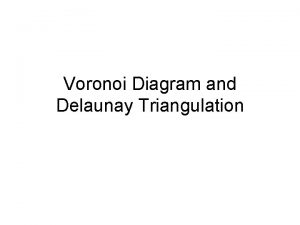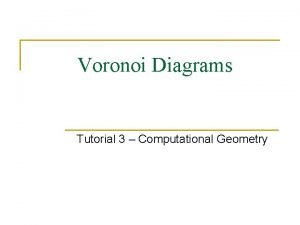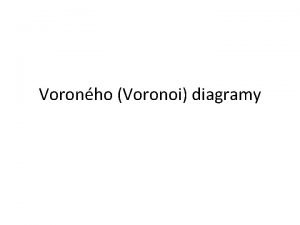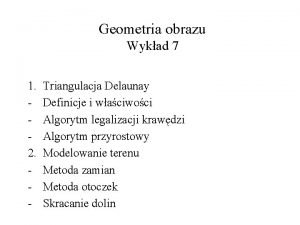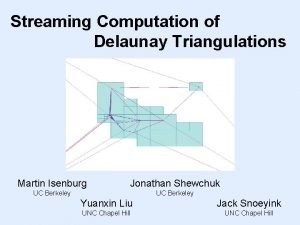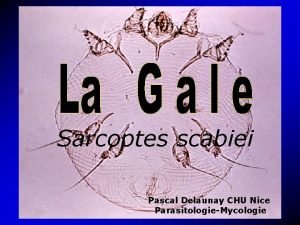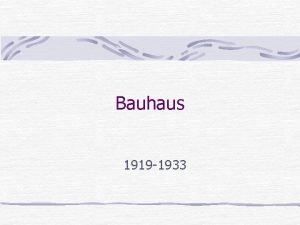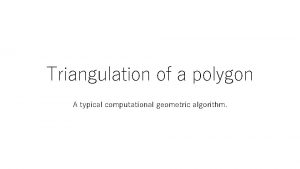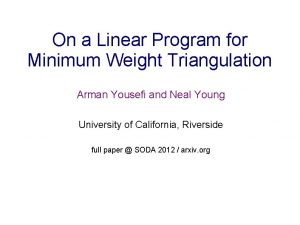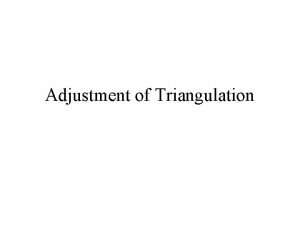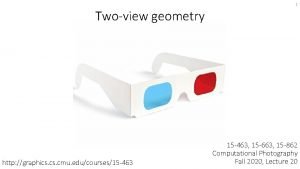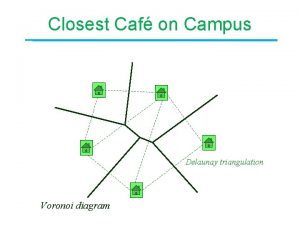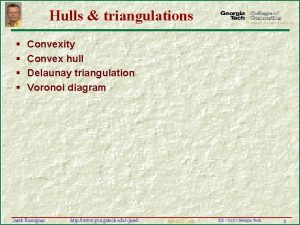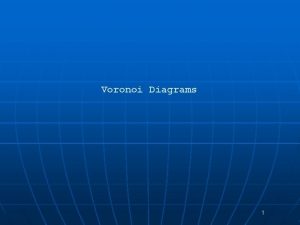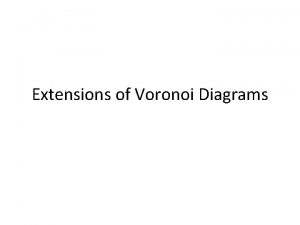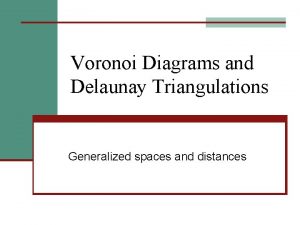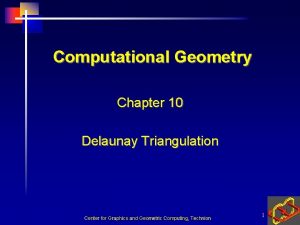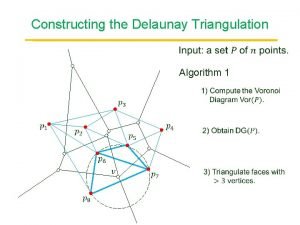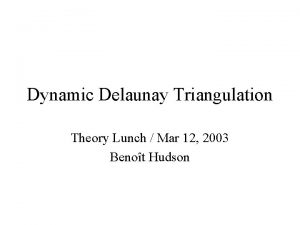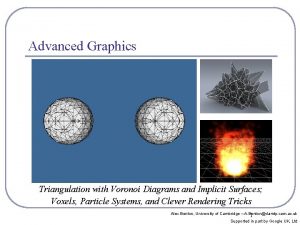Voronoi Diagram and Delaunay Triangulation Voronoi Diagram To



























- Slides: 27

Voronoi Diagram and Delaunay Triangulation

Voronoi Diagram • To find the nearest neighbors of points in the plane p 2 p 1 L 12

The Voronoi diagram problem • E. g. The Voronoi diagram for three points 3 Each Lij is perpendicular bisector of the line connecting the pair of points


Applications • 「資料分群與樣式辨認(Data Clustering and Pattern Recognition)」 • 應用Voronoi Diagram於臺北盆地地下水模式參 數最佳化之研究 • 採用二維Voronoi網路(Voronoi diagram)模型, 從 微觀角度分析氧化鋅非線性電阻片中的電流、溫 度和熱應力的分布 • Simulation of polycrystalline structure with Voronoi diagram

The Voronoi diagram problem • Def : Given two points Pi, Pj S, let H(Pi, Pj) denote the half plane containing Pi. The Voronoi polygon associated with Pi is defined as 6

The Voronoi Polygram 7

The Voronoi diagram problem • Given a set of n points, the Voronoi diagram consists of all the Voronoi polygons of these points. • E. g. A Voronoi diagram of 6 points: 8 • The vertices of the Voronoi diagram are called Voronoi points and its segments are called Voronoi edges.

Voronoi Diagram • 1644: informal use by Descartes • 1850: Dirichlet used 2 -dimensional and 3 dimensional Voronoi diagrams in his study of quadratic forms • 1854: British physician John Snow used a Voronoi diagram in 1854 to illustrate how the majority of people who died in the Soho cholera epidemic lived closer to the infected Broad Street pump than to any other water pump.

Voronoi Diagram • 1908: Voronoi diagrams are named after Russian mathematician Georgy Fedoseevich Voronoi (or Voronoy) who defined and studied the general ndimensional case. • Voronoi diagrams are used in geophysics and meteorology to analyze spatially distributed data

• Voronoi: Russian • Delaunay: French

The Voronoi diagram problem • A Delaunay triangulation: 12

Divide-and-Conquer approach • Input : A set S of n planar points. • Output : The Voronoi diagram of S. • Step 1 If S contains less than 4 point, solve directly and return. • Step 2 Find a median line L perpendicular to the X-axis which divides S into SL and SR such that SL (SR) lies to the left(right) of L and the sizes of SL and SR are equal. 13

Divide-and-Conquer approach • Step 3 Construct Voronoi diagrams of SL and SR recursively. Denote these Voronoi diagrams by VD(SL) and VD(SR). • Step 4 Construct a dividing piece-wise linear hyperplane HP which is the locus of points simultaneously closest to a point in SL and a point in SR. Discard all segments of VD(SL) which lie to the right of HP and all segments of VD(SR) that lie to the left of HP. The resulting graph is the Voronoi diagram of S. 14

How to merge two Voronoi diagrams ? 15

How to merge two Voronoi diagrams ? • Merging: 16 b 15 b 45 b 14 b 13 b 34 b 46 b 36 b 23 b 26

Merges Two Voronoi Diagrams into One Voronoi Diagram • Input : (a) SL and SR where SL and SR are divided by a perpendicular line L. (b) VD(SL ) and VD(SR ). • Output : VD(S) where S = SL ∩SR • Step 1 Find the convex hulls of SL and SR. Let them be denoted as Hull(SL) and Hull(SR), respectively. (A special algorithm for finding a convex hull in this case will by given later. ) 17

Merges Two Voronoi Diagrams into One Voronoi Diagram • Step 2 Find segments and which join HULL(SL ) and HULL(SR ) into a convex hull (Pa and Pc belong to SL and Pb and Pd belong to SR) Assume that lies above. Let x = a, y = b, SG= and HP = . • Step 3 Find the perpendicular bisector of SG. Denote it by BS. Let HP = HP∪{BS}. If SG = , go to Step 5; otherwise, go to Step 4. 18

Merges Two Voronoi Diagrams into One Voronoi Diagram 19 • Step 4 The ray from VD(SL ) and VD(SR) which BS first intersects with must be a perpendicular bisector of either or for some z. If this ray is the perpendicular bisector of , then let SG = ; otherwise, let SG =. Go to Step 3. • Step 5 Discard the edges of VD(SL) which extend to the right of HP and discard the edges of VD(SR) which extend to the left of HP. The resulting graph is the Voronoi diagram of S = SL∪SR.

Merges Two Voronoi Diagrams into One Voronoi Diagram • Def : Given a point P and a set S of points, the distance between P and S is the distance between P and Pi which is the nearest neighbor of P in S. • The HP obtained from the above algorithm is the locus of points which keep equal distances to SL and SR. • The HP is monotonic in y. 20

Merges Two Voronoi Diagrams into One Voronoi Diagram # of edges of a Voronoi diagram 3 n - 6, where n is # of points. Reasoning: • • i. # of edges of a planar graph with n vertices 3 n - 6. ii. A Delaunay triangulation is a planar graph. iii. Edges in Delaunay triangulation edges in Voronoi diagram. 21

Construct Convex Hull from Voronoi diagram • After a Voronoi diagram is constructed, a convex hull can by found in O(n) time. 22

Construct Convex Hull from Voronoi diagram • Step 1 : Find an infinite ray by examining all Voronoi edges. • Step 2 : Let Pi be the point to the left of the infinite ray. Pi is a convex hull vertex. Examine the Voronoi polygon of Pi to find the next infinite ray. • Step 3 : Repeat Step 2 until we return to the Starting ray. 23

Time complexity • Time complexity for merging 2 Voronoi diagrams: – Step 1: O(n) – Step 2: O(n) – Step 3 ~ Step 5: O(n) (at most 3 n - 6 edges in VD(SL) and VD(SR) and at most n segments in HP) T(n) = 2 T(n/2) + O(n)=O(n log n) 24

Lower bound • The lower bound of the Voronoi diagram problem is (n log n). ∵sorting Voronoi diagram problem The Voronoi Diagram for a Set of Points on a Straight Line 25

Optimality • The divide-and-conquer algorithm for solving the Voronoi diagram problem is optimal

Applications of the Voronoi diagrams • The Euclidean nearest neighbor searching problem. O(log n) with O(n log n) preprocessing • The Euclidean all nearest neighbor problem. O(n) with O(n log n) preprocessing 27
 Voronoi diagram
Voronoi diagram Delaunay triangulation divide and conquer algorithm
Delaunay triangulation divide and conquer algorithm Delaunay triangulation
Delaunay triangulation Voronoi diagram tutorial
Voronoi diagram tutorial Diagram voronoi
Diagram voronoi Dynamism of a dog on a leash analysis
Dynamism of a dog on a leash analysis E
E Delaunay
Delaunay Pascal delaunay
Pascal delaunay Sonia delaunay bauhaus
Sonia delaunay bauhaus Toxic waste dump problem voronoi
Toxic waste dump problem voronoi Matematika mindenkinek
Matematika mindenkinek Bluetooth positioning using rssi and triangulation methods
Bluetooth positioning using rssi and triangulation methods Monotone polygon triangulation
Monotone polygon triangulation Triangulation
Triangulation Triangulation surveying
Triangulation surveying Triangulate
Triangulate Triangulation vs crystallization
Triangulation vs crystallization Minimum weight triangulation
Minimum weight triangulation Sample rationale of the study
Sample rationale of the study Steps in triangulation method in earthquake
Steps in triangulation method in earthquake Oedipal triangulation
Oedipal triangulation Data analysis and interpretation examples
Data analysis and interpretation examples What is gps triangulation
What is gps triangulation Trilateration vs triangulation
Trilateration vs triangulation Homorogeneous
Homorogeneous La triangulation en évaluation
La triangulation en évaluation Triangulation police
Triangulation police
